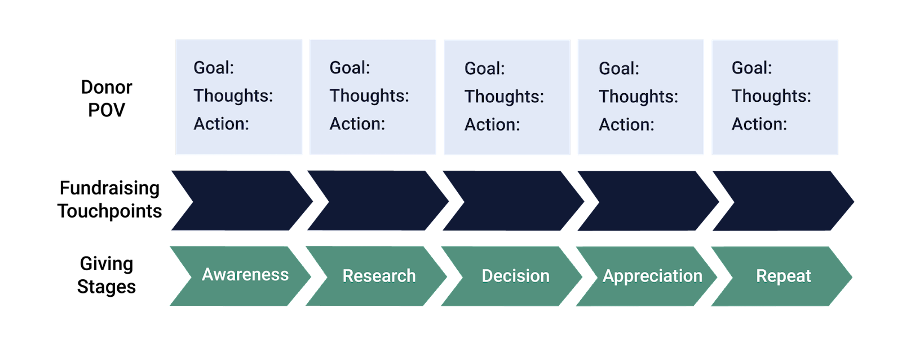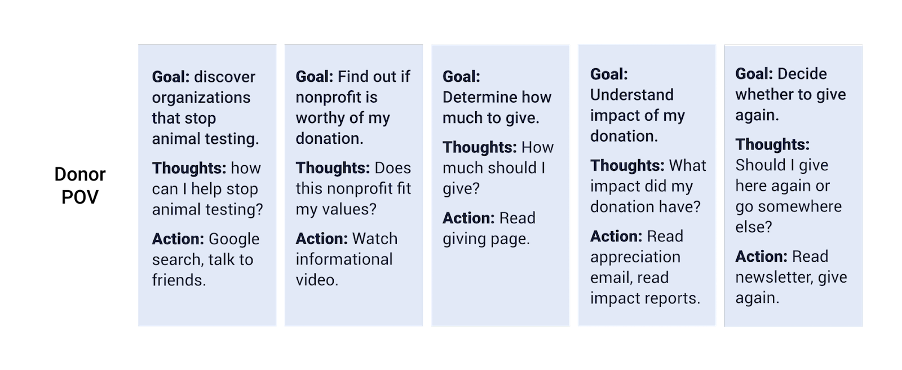How to create a donor journey map
Ally Smith of Fundraising KIT shows you how to create a donor journey map and shares why they’re important to your fundraising strategy.
- Written by
- Ally Smith
- Added
- June 29, 2022
For centuries, maps have helped us navigate foreign countries, complex city streets, and even our own hometowns. As fundraisers, maps can help us navigate relationships with our donors.
Donor journey mapping is the process of stewarding your non-profit’s supporters and potential donors to become recurring donors and advocates for your cause. This process can be visualised using a map that illustrates the key stages supporters go through as they move along their journey.
This article will explore the importance of creating and using donor journey maps to develop stewardship plans for your most promising supporters. It will also highlight the key stages of your donor journeys.
Why your non-profit should create a donor journey map
Building a donor journey map is a valuable exercise for every fundraising team. ‘Why?’ you might ask? Well, when you know when, where, and how your donors are connecting with you, you can be better equipped to understand your fundraising successes and shortfalls.
This practice is also a great way to get your team focused on donor-centred stewardship practices and strategies. Additionally, it will help your team understand the decisions your donor base makes as you nurture your relationship with them.
An effective donor journey map will help your non-profit team to do the following:
- Learn more about your donors: By understanding where your donors are and how and why they’re giving, your team can identify the key factors that motivate donors and create a strategy around those factors.
- Keep your team aligned: The donor journey map provides a framework that your entire team can use to promote donor engagement. Additionally, it will help your team stay on the same page.
- Improve donor experience: As your team creates donor journeys, they’ll start to understand opportunities and gaps in your strategy and develop opportunities for improvement.
- Visualise the future: An essential part of non-profit development involves forecasting and projecting fundraising outcomes. With a donor journey map, you can predict what donors will contribute over time and use that information to estimate outcomes.
- Monitor your progress: Mapping the donor journey can help you understand the stages where you’re losing donors or converting donors well. Then, through mapping your success, you can spot areas for improvement.
How to create a donor journey map to increase revenue
Let’s walk you through an example donor journey map using an animal rights advocacy non-profit as an example:
Nancy is a baby boomer and an active donor who supports animal rights causes. Nancy’s annual salary is approximately US$100,000, and she is prepared to donate US$50 to US$70 each month to this non-profit.
Now, let’s look at what a donor journey map would look like, and as we explore it, we’ll discuss how Nancy’s journey plays out.
Your map should have three components: giving stages, fundraising touchpoints, and the donor's point of view (POV).

Let’s start by looking at the giving stages component.
Giving stages
You are likely already familiar with the donor giving stages: awareness, research, decision, appreciation, and repeat.

Donors interact with your non-profit at each of these stages.
By progressing through these stages, you strive toward the goal of encouraging donors to become repeat or recurring donors. Achieving this goal can take a while and will require patience.
In practice, donors might actually loop back to the research stage after the decision stage or even skip the research phase altogether. However, the most important factor is that they keep moving between stages.
Fundraising touchpoints
Fundraising touchpoints are the recorded interactions you’ll have with your donor during each giving stage. It’s vital that you develop communications from the donor's perspective.
Here is an example of what that might look like in Nancy’s case:

Donor point of view (POV)
Working your donor POV into your donor journey is critical and involves considering your donors’ long-term goals, thoughts, and activities as they go from one stage to the next.
When assuming a donor’s POV, you should begin by clearly defining your audience. Then, if you use a non-profit customer relationship management, or CRM, you can analyse your database to learn more about your best supporters and most consistent donors. This process will give you some insight to help you anticipate the POV of promising supporters with similar characteristics.
Make sure to consider the campaigns that your supporters tend to contribute to. Additionally, take note of their age, gender, preferred communication methods, and average gift size.
Let’s go back to Nancy. Based on your donor base analysis, you’ll need to think strategically about what Nancy would think as she progresses through her giving stages. Here’s what that might look like:

Once you’ve established Nancy’s POV, you have everything you need to monitor her progress and help give her the donor experience she’s looking for and deserves.
When you put these three pieces together (giving stages, fundraising touchpoints, and donor POV), you’ll have a complete donor journey map that’ll inform your non-profit’s fundraising strategy. So, take some time to create a donor journey map for your organisation’s most impactful supporters and increase your fundraising success
Remember, you should begin this process by identifying your ideal donors. To do that, you can use KIT’s free Donor Profile Template to organise your donors’ information and identify your most engaging donors.
Good luck! We are excited to hear how you create these journeys and continue to raise more funds for your cause.
















